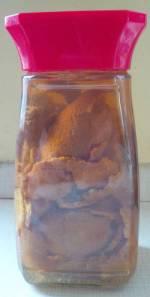Basking Shark
Cetorhinus maximus
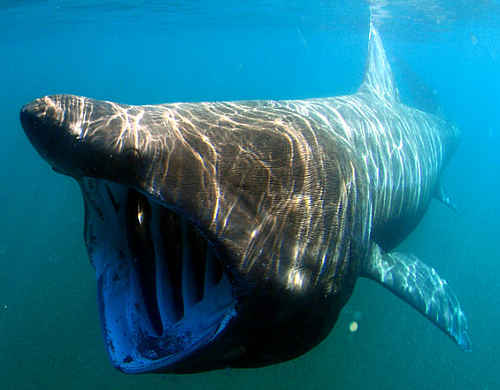
|
The Basking shark, or cetorhinus maximus, belongs to the order Lamniformes and the family Cetorhinidae. C. maximus. It is currently the only member of the family. It has been suggested that there may be as many four species but, as yet, there is insufficient evidence to support this theory. So, for now at least, this big guy gets the family all to himself. |
|
Size and shape
Pups are between 150 - 170cm at birth. Mature males average around 570cm and females around 800cm. Though it's rare, they may grow to as long as 1100cm.
They are the second largest fish on earth, with only the whale shark being bigger. Like the whale shark they have enormous mouths which may be up to 100cm across.
They also have a longish snout that protrudes above the mouth. I probably have a soft spot for this shark because I have a thing about long snouts. Just ask my poor greyhound how many 'needlenose' kisses he gets every day.
In juveniles the snout resembles a small trunk which may be why they are sometimes called elephant sharks.
Despite their huge size and slow speeds, they are known to occasionally leap fully out of the water. They may do this to dislodge parasites though it's not known for sure. Maybe they do it just for fun.
Colouring
They vary from brownish-grey to dark grey or almost black on top and paler to white underneath. They may have mottled markings on their back and sides and white blotches under the head.
Fins
They have a large triangular dorsal fin set halfway down the body about midway between the paired pectoral and pelvic fins. A second, much smaller dorsal fin sits well back on the tail more or less above the anal fin.
The caudal fin is almost symmetrical with the lower lobe being almost equal in size to the upper lobe. Strong caudal keels are present on the caudal peduncle.
Teeth
Their teeth are the same in the upper and lower jaws. They have more than 150 rows of tiny teeth which are curved backwards.
Diet
This shark is a filter feeder, hence the huge mouth. It also has very large gill slits which almost fully encircle the head. They have bristle-like gill rakers to filter their food from the water. These are periodically shed and replaced.
It was once thought that basking sharks shed their gill rakers in the winter and spent the season resting on the seabed. It's now thought that they may actively feed all year round but that they spend the winter in deeper waters.
They feed entirely on plankton by ram filtration.
Reproduction
Little is known about reproduction in these sharks. Ovovivparous with possible oophagy. Number of pups per litter is unknown though probably averages about six. Gestation is thought to be somewhere from 12 to 16 months though it has been suggested it may be as long as three and a half years.
Distribution
Worldwide in cold to temperate waters. They range in depth from the surface to around 570m.
Basking Shark Distribution Map
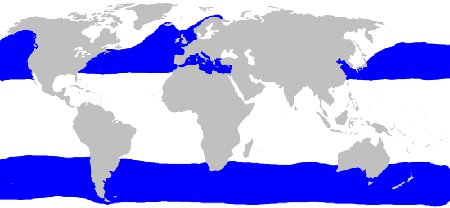
Return to World of Sharks from Basking Shark
Classification
Phylum: Chordata
Class: Chondrichthyes
Subclass: Elsamobranchii
Order: Lamniformes
Family: Cetorhinidae
Genus: Cetorhinus
Species: maximus
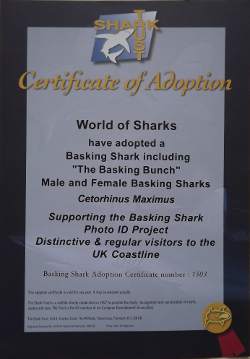
If you love basking sharks as much as we do you can adopt one from The Shark Trust.
The money goes into projects researching these amazing animals.
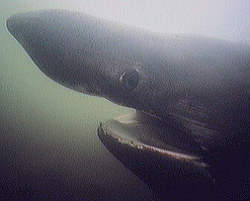
Love it!
I have a thing about long snouts.
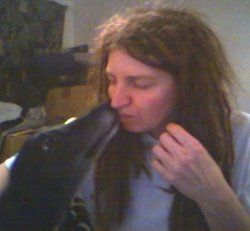
The evidence!
'Needlenose' kisses. Just can't resist anything with a long snout.
Recent Articles
-
Thresher Sharks
Aug 27, 14 10:51 AM
Thresher sharks are unmistakable with that huge upper lobe on the caudal fin. Let's find out more about them. -
Sharkwater
Aug 14, 14 12:42 PM
Sharkwater is a documentary by Rob Stewart highlighting the plight of the sharks in our oceans. -
Natural Cleaners
Aug 13, 14 08:57 AM
Natural cleaners and homemade skincare products are not only better for the environment, they're better for you and your family.
